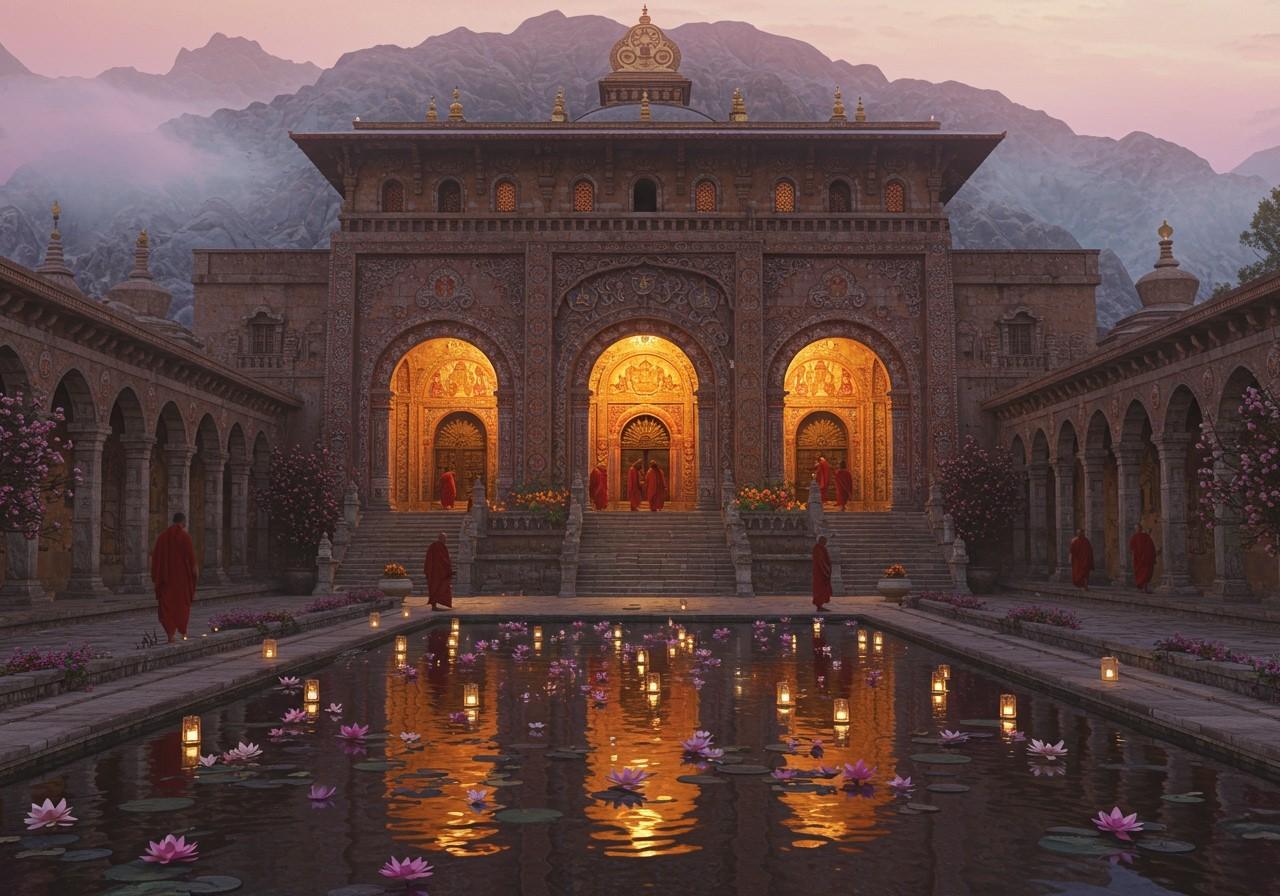
Viharas hold a significant place in Buddhist traditions, serving as monastic complexes where monks reside and engage in religious practices. These serene spaces foster spiritual growth and community development. The term “Vihara,” derived from Sanskrit, signifies “dwelling” or “abode.” Emerging in India around the 5th century BCE, Viharas are found in regions such as Bihar, Uttar Pradesh, and the Deccan plateau. Let’s delve into their distinctive architectural and decorative elements.
The Architectural Design of Viharas
Viharas typically feature a central courtyard encircled by the monks’ living quarters. This courtyard plays a vital role as a space for meditation and communal gatherings. Key components within Viharas include the Stupa, Chaitya, and Vihara Hall, each serving a distinct purpose in religious practices. Regional styles influence Vihara architecture, as seen in Maharashtra’s rock-cut Viharas and Southeast Asia’s ornate designs. The use of local materials like stone and wood ensures sustainability and harmony with the natural surroundings. Natural landscapes are often integrated into the design, fostering a tranquil ambiance. Iconic examples include the Ajanta and Ellora caves, renowned for their architectural significance, similar to the Borobudur temple complex in Java, Indonesia, a notable example of Buddhist architecture following the mandala design, symbolizing a spiritual journey.
Decorative Elements in Viharas
Viharas, adorned with artistic designs, embody the essence of Buddhist spirituality and culture. Intricate carvings and sculptures bring the stories of Buddha and Jataka tales to life, serving as both educational and inspirational elements. These artworks offer glimpses into the rich history of Buddhism.
Murals and frescoes grace the walls of Viharas, serving not merely as decoration but also as visual guides to understanding Buddhist teachings. With their vibrant colors and intricate details, these artistic expressions draw viewers into a world of peace and contemplation.
Recurring motifs in Vihara decorations include lotus flowers, Bodhi trees, and the Dharma wheel. Each symbol holds deep meaning: the lotus represents purity, the Bodhi tree symbolizes enlightenment, and the Dharma wheel signifies the path to truth. These motifs connect visitors to the spiritual journey that Buddhism offers.
Often, Viharas incorporate Hindu elements, showcasing the harmonious blend of religious traditions in India. This syncretism enriches the cultural tapestry of Viharas, making them unique and historically significant. The Ajanta caves, for instance, showcase remarkable paintings that capture the heart of Buddhist philosophy, much like the cave temples in China, carved from rock and significant in Chinese Buddhist art and architecture. Similarly, the stone carvings at the Mahabodhi Temple exemplify the dedication and skill of ancient artisans.
The Role of Viharas in Buddhist Monastic Life
Viharas are more than just physical structures; they are vibrant centers of learning and spiritual practice. Within their walls, monks find a sanctuary for meditation, study, and communal living, forming the foundation of monastic life. Daily rituals, such as chanting, teaching, and almsgiving, bring a sense of rhythm and purpose to life in the Viharas, fostering a strong sense of community among monks and laypeople.
Viharas play a vital role in preserving and transmitting Buddhist teachings across generations. A strong bond exists between Viharas and the surrounding communities. They serve as hubs for social welfare and cultural exchange, enriching the lives of both monks and locals. Pilgrims visit Viharas seeking spiritual guidance, finding solace and blessings within these sacred spaces.
Prominent Viharas, such as Nalanda and Bodh Gaya, have significantly shaped Buddhist monastic traditions over centuries, standing as pillars of Buddhist heritage.
The Evolution and Influence of Vihara Architecture
Vihara architecture has transcended its Indian origins, spreading alongside Buddhism along trade routes. Countries like Sri Lanka, Thailand, and Tibet embraced and adapted Vihara designs, incorporating local climates and cultural influences, resulting in diverse architectural expressions. This evolution demonstrates the resilience and adaptability of Vihara architecture. Buddhist architecture, in turn, has inspired other religious styles, including Hindu temples and Jain monastic complexes, reflecting a shared cultural heritage. Historical events, such as invasions, have impacted the preservation and transformation of Viharas. Despite these challenges, Viharas stand as testaments to the diversity of Buddhist architecture.
Modern Viharas blend contemporary techniques with traditional elements, ensuring their continued relevance. They actively preserve Buddhist heritage on a global scale, inviting admiration and scholarly study.
How Poojn.in Enhances Your Vihara Experience
Poojn.in offers carefully curated items that complement the serene and spiritual atmosphere of Viharas and spaces inspired by their architectural principles. For those seeking to create a meditative space reminiscent of these sacred sites, we provide:
-
Adiyogi marble dust murti (₹379): Ideal for meditation corners and personal shrines, bringing a touch of spiritual grace to your Vihara-inspired space. This beautifully crafted murti adds a sense of reverence and tranquility to your practice.
-
Bamboo Chalon (15-inch diameter): These traditional bamboo trays are perfect for offering ceremonies and maintaining cleanliness in prayer areas. Their natural aesthetic complements the Vihara’s emphasis on harmony with nature.
These and other products are available for convenient online purchase at www.poojn.in with delivery across India. Each item is thoughtfully selected to honor authenticity and support traditional practices in contemporary settings. Explore our complete collection of ritual items and spiritual accessories, aligning with the principles of Vihara architecture.
Conclusion: A Timeless Journey
Vihara architecture, with its rich history and profound spiritual significance, remains a vital aspect of Buddhist culture. These sacred spaces, adorned with meaningful symbols and artistic marvels, connect us to centuries of tradition and wisdom. As centers of learning and spirituality, Viharas provide sanctuary for monks and pilgrims alike, weaving a tapestry of community and enlightenment. The enduring influence of Viharas across Asia highlights their adaptability and timeless appeal. By embracing modern techniques while honoring traditional designs, Viharas continue to inspire awe and reverence. They invite us on a journey of peace, reflection, and cultural heritage—a journey as relevant today as it was in ancient times.


